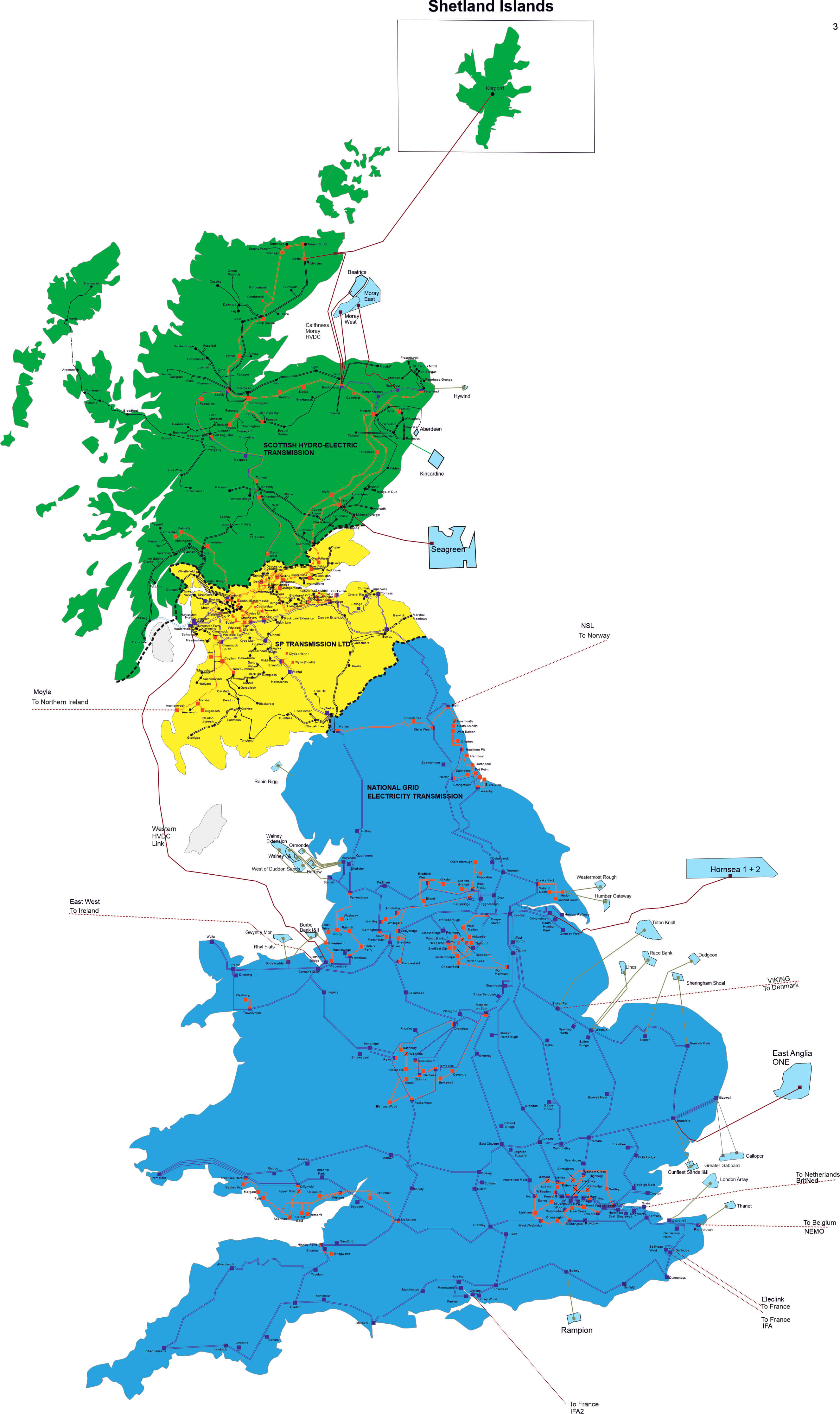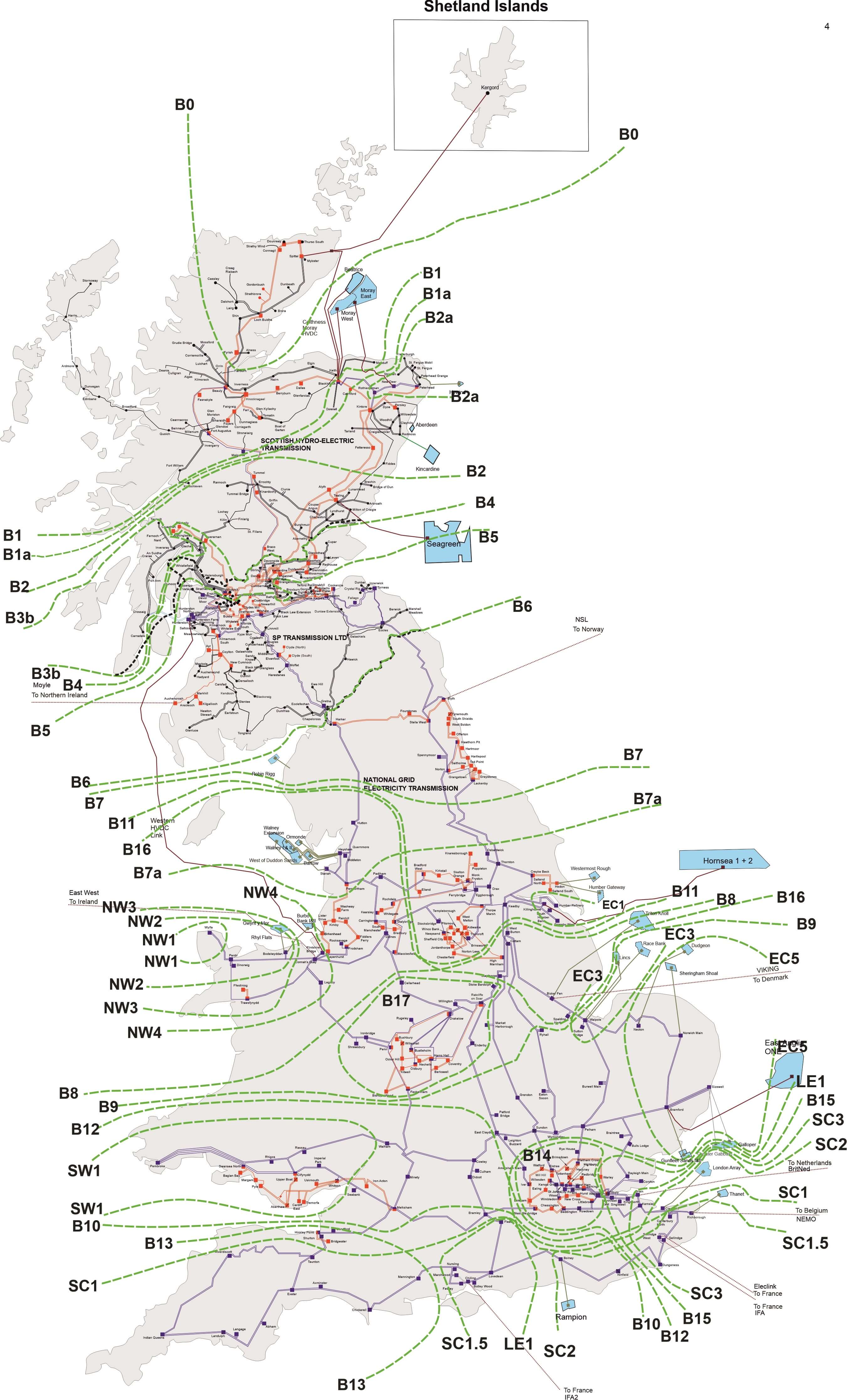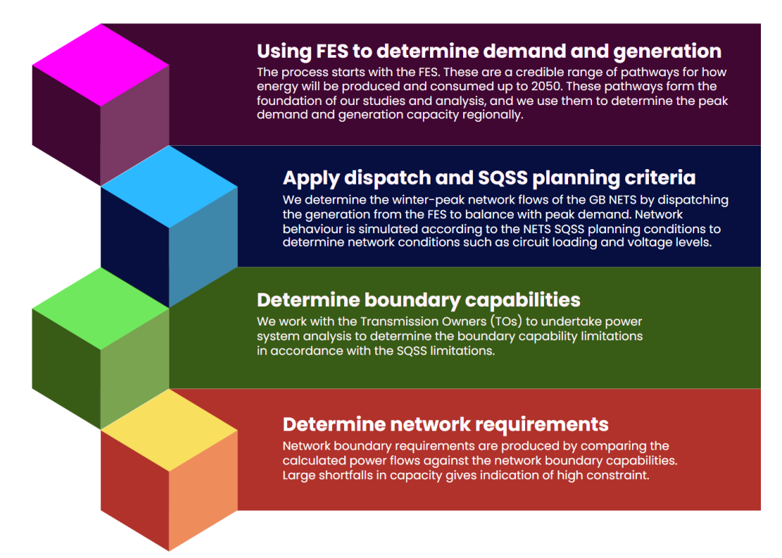Our ETYS analysis
National Electricity Transmission System (NETS)
NESO is responsible for operating the transmission networks in England, Wales, Scotland and in the surrounding offshore waters.
The National Electricity Transmission System (NETS) spans Great Britain and is comprised of overhead lines as well as underground and subsea cables, at 132 kV, 275 kV and 400 kV voltage levels.*
These are all linked together via substations across the country which connect separately owned generators, interconnectors, large demands, and distribution systems. Electricity Distribution comprises of network below 275 kV in England and Wales and below 132 kV in Scotland respectively, which are the responsibility of Distribution Network Operators (DNOs). It transports electricity from transmission “highways” to the end consumer.

Great Britain has three onshore Transmission Owners (TOs) that separately own the network. These are:
- Scottish & Southern Energy Networks Transmission - owning the network in the north of Scotland.
- Scottish Power Transmission - owning the network in the south of Scotland.
- National Grid Electricity Transmission – owning the transmission network in England and Wales.
There are also 27 licenced offshore transmission owners (OFTOs) appointed through Ofgem’s competitive tendering process. They own the assets that connect operational offshore wind farms to the transmission or distribution network.
Together with the Transmission Owners, we regularly assess and model network behaviour under different conditions to test its resilience. We assess where the network may be under strain for various reasons and this analysis accumulates into the ETYS. This ensures we portray an accurate representation of the current transmission capabilities and identify future requirements.
*Some of the transmission network in SSEN-T consists of 220kV subsea cables.
Boundary analysis
Learn more about how we analyse the transmission network:
What is a boundary?
A boundary splits the transmission system into two parts, crossing critical circuit paths that carry power between the areas where power flow limitations may be encountered.
Defining the boundaries has evolved over many years of planning and operating the system, which means that when significant changes occur, new boundaries may be defined, and some boundaries are either removed or amended.
We do not study all boundaries, specifically those where no significant changes are identified in the FES generation and demand data compared to previous years. We assume the same capability as the previous year for these boundaries.
The boundaries used by ETYS can be split into two different types:
Local boundaries
Small areas of the NETS with a high concentration of generation. These small power export areas can give high probability of overloading the local transmission network due to too much generation operating simultaneously.
Wider boundaries
Large areas containing significant amounts of both generation and demand. The System Security and Quality of Supply Standard (SQSS) boundary scaling methodologies assess the capability of the wider boundaries. These consider both the geographical and technological effects of generation, allowing for a consistent capability and requirements assessment.

Determining boundary capability
Boundary Capability is the maximum power flow that can be securely transferred across the boundary while maintaining compliance with the NETS SQSS.
The SQSS has fixed rules for planning and operating the NETS. The NETS has to be kept secure against credible events such as network faults and loss of generation; while making sure circuits are not overloaded, and voltages and frequency are kept within limits.
For each boundary, we work with the transmission owners to undertake power system analysis, determining the boundary capability. Limiting factors on transmission capacity include:
- Thermal circuit rating
- Voltage constraints
- Dynamic stability
For the ETYS network assessment, contingencies are applied, and the most severe SQSS limitation is used to determine the network boundary capability. The base capability of each boundary can be seen in the Electricity Transmission Network Requirements section.

How do NESO manage voltage?
To keep voltage stable and within SQSS limits, it can be increased by injecting reactive power or decreased by absorbing reactive power. Generators on the system can provide reactive power control when they are generating electrical power. The MITS network itself can also be controlled to manage reactive power; this could come from reactive compensation equipment, such as Synchronous condensers, Static VAR compensators, STATCOM, Mechanically Switched Capacitors or Shunt Reactors. In some cases, voltage can also be controlled from the electrical properties of cables and overhead lines.
In the past, NESO was responsible for managing low voltage, but now that there are fewer industrial processes and spinning turbines, we often must manage higher than normal voltages.
Voltage is a localised property of the transmission system determined by configuration of the local network and the nature of generation and demand in a region. Unlike real power, reactive power has a localised effect, so voltage control measures are most effective when applied closer to the problem. These issues can therefore be grouped into regions, with an assessment of each conducted separately.
Similar to last year – voltage needs on the NETS will be communicated at a high level in our ‘Regional Drivers’ sections, within Electricity Transmission Network Requirements.
Stability needs in the ETYS
Our ambition is to communicate a long-term view of year-round stability needs in future ETYS/CSNP publications with more specific procurement needs communicated through our stability market, which is still under development.
Further work is still ongoing to develop tools and techniques to allow year-round long-term stability analysis (via automation). Once our tools and processes mature, we will integrate a long-term view of stability needs within the CSNP’s annual cycle.
Stability Market
The Stability Markets allow NESO to secure operation of the network at lowest cost to consumers. These will replace the previous Stability Pathfinders, through which we had procured long-term stability network services. However, all units from Stability Pathfinder Phase 1 are now operational and assets contracted under phases 2 and 3 will come online from 2024.
We are actively implementing three enduring stability markets to meet our stability needs more effectively. As recommended by the Stability Market Design Network Innovation Allowance project which concluded in 2023, we are implementing new stability markets:
- Long-term (Y-4),
- Mid-term (Y-1), and
- Short-term (D-1).
These will allow us to signal new investment when and where we need it, and more immediately provide a route to market for assets capable of delivering stability services in the present, and those which could do so in the future with additional investment. The first tender round under the mid-term (Y-1) stability market was launched in 2023 procuring stability services for delivery from 1st October 2025 until 30th September 2026. You can find more detail on this and other balancing services markets in the Markets Roadmap 2024.
Innovation Projects
STARTZ - Stability Requirements Calculation Toward Net-Zero
Current stability calculation methods use a number of assumptions and approximations however there is an opportunity to make the process more accurate. This project reviews NESO’s stability requirement calculations and explores the potential for new methodologies, machine learning and automation to enhance accuracy and efficiency to inform procurement market activities and future network planning. Suggested improvements to the methodology will be tested and validated against detailed system modelling.
This project will support the energy transition by ensuring the grid remains stable while more renewable generation is integrated into the network. It will provide value for money for consumers as there is less variance in our estimates, so the balancing services required will be more accurately predicted and procured. The potential to use automation and machine learning to calculate stability needs will make the process more efficient and reduce the risk of human error which could affect the results. Further details available here.
Enhanced RMS (e-RMS) Models for Stability Assurance
Developing an enhanced RMS (e-RMS) modelling framework that can provide dynamic stability assurance in planning studies and at operation timescale without carrying the cost of being overly conservative.
Existing models struggle to anticipate instability issues caused by inverter-based resources (IBRs). The project's development of an enhanced RMS (e-RMS) model for IBRs, functioning as digital twins of high-fidelity IBR models, addresses these challenges. It enables a more thorough analysis of IBR-dominated systems, effectively allowing for greater renewable integration without compromising grid stability. Further details available here.
